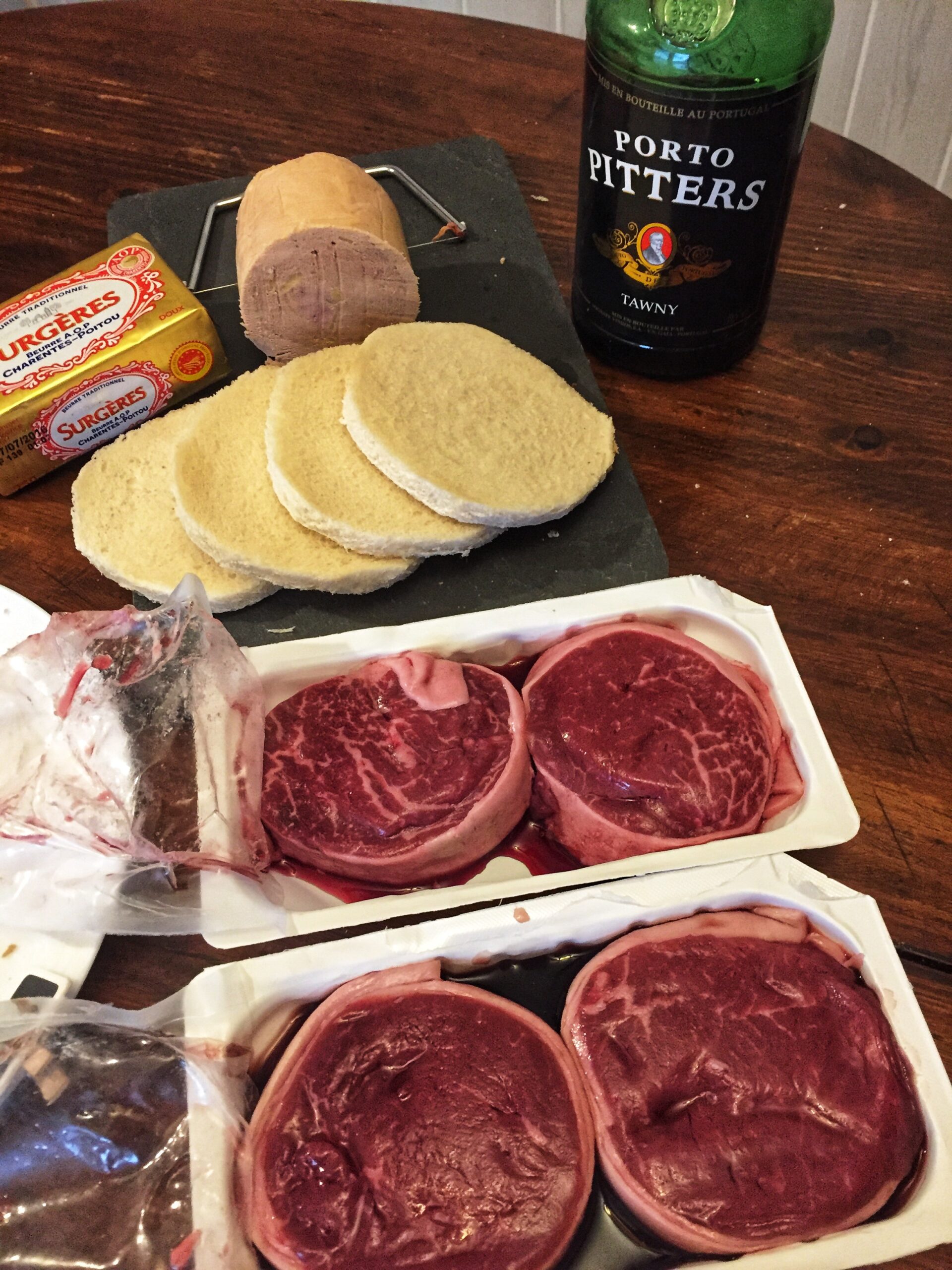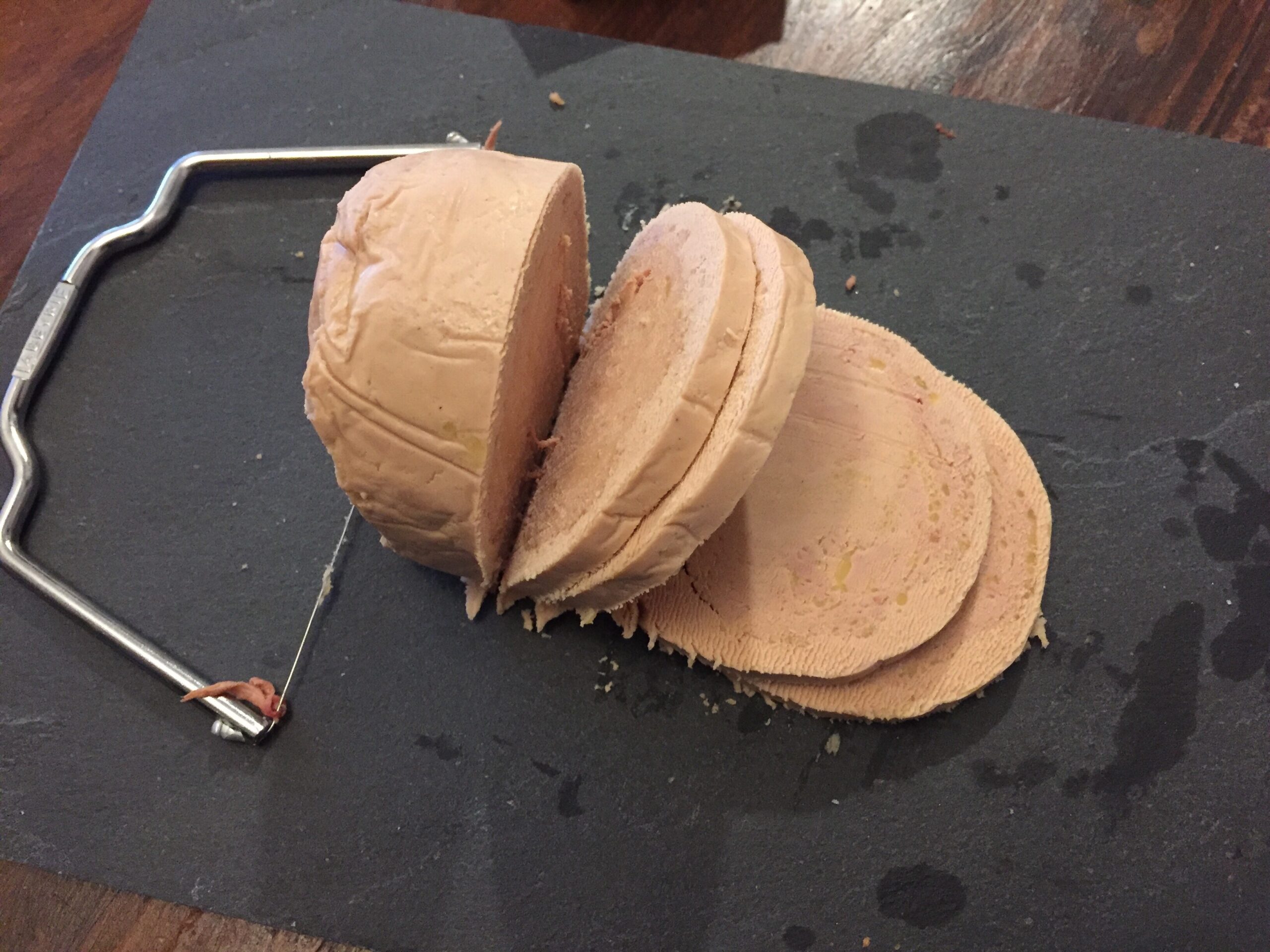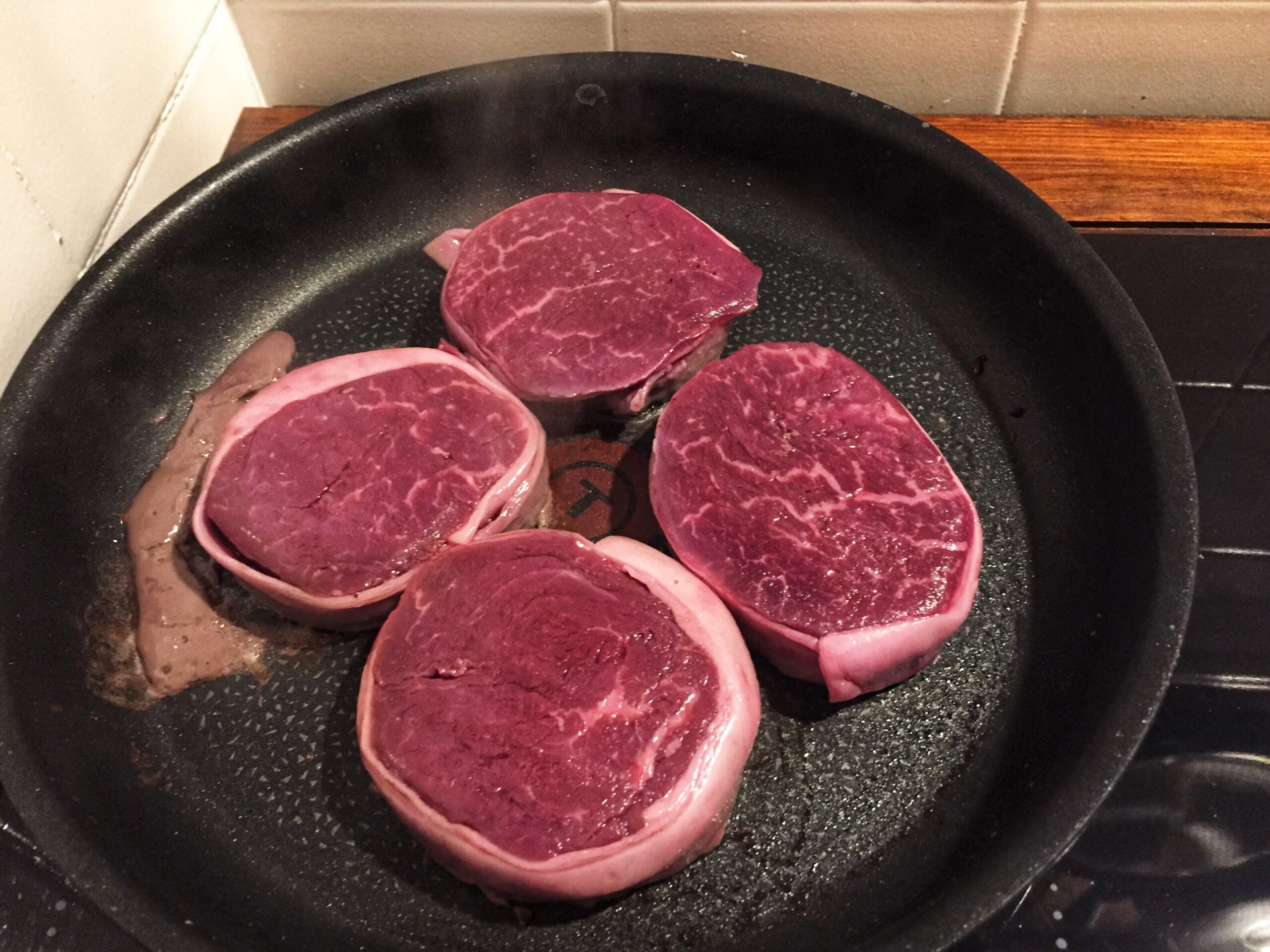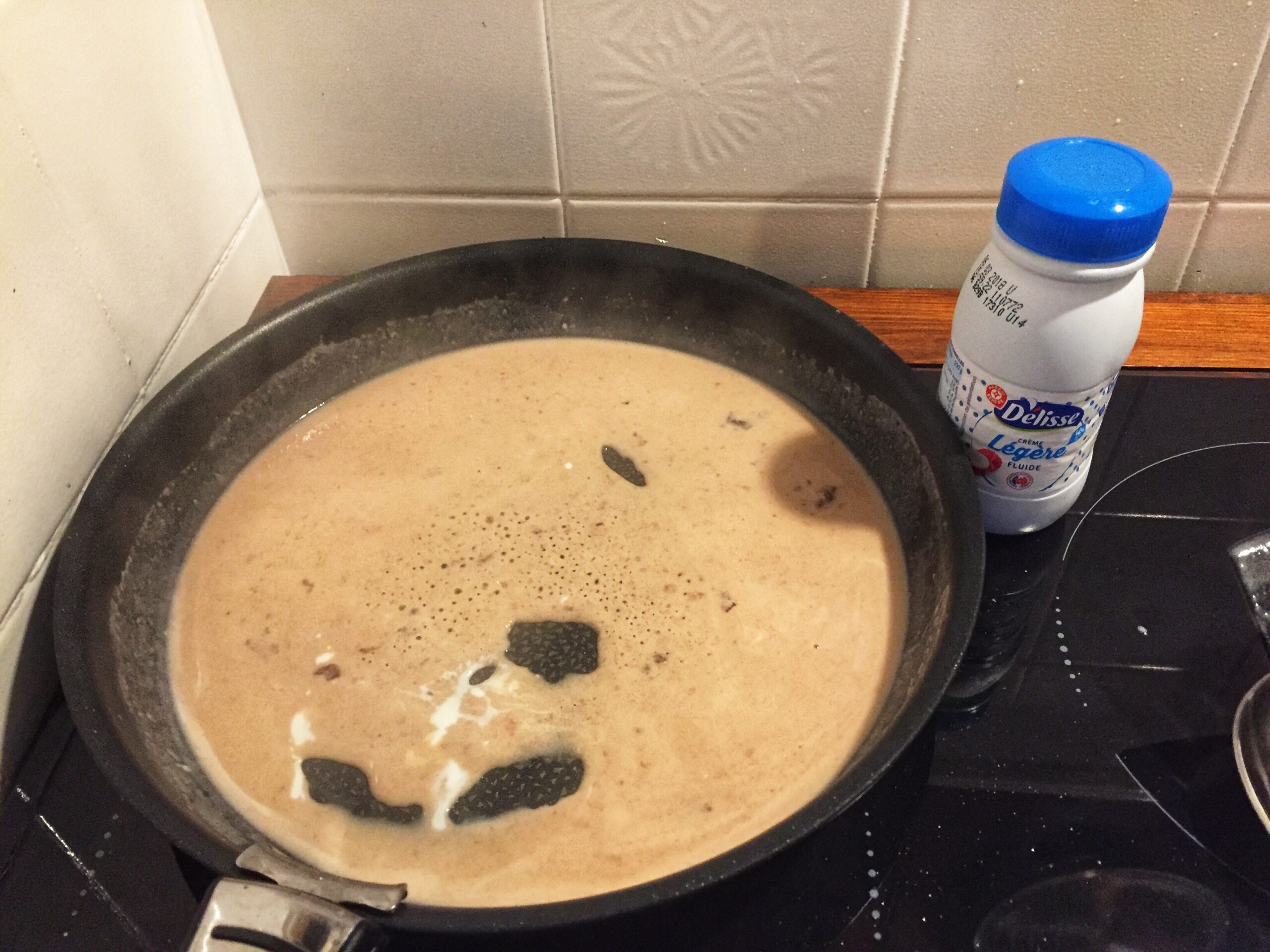Here are a few general tips and extensive recommendations in/around Tokyo, and outside of Tokyo (Kyoto, Miyajima island, Kobe, the Japanese macaques near Nagano), since I compiled the data for Anne (he asked nicely!).
There is not much in this post about food and restaurants because it is far more subjective than sight-seeing. However, I’d say that it would be a mistake not to buy Melon Pan (a pastry, the size of a bread roll) daily at the very least 😉
General tips
General considerations:
Japan is exquisitely beautiful. Most everything is tasteful. Aesthetically, it has to be the world’s top destination (it certainly is mine!). I have had the good fortune to visit 7 or 8 times, at various times of year, and it’s always enchanting.
Japan is very safe.
The Japanese people are respectful, courteous, quiet, curious, helpful and fair.
Sim cards for visitors:
2024 update: Because smartphones nowadays mostly support eSim cards (software-based), I used Ubigi which has several plans for visitors. The advantages are that activation happens when you decide it (using a QR code), and you can recharge you data credits at the same price. For the latter, the drawback is that you’ve got to do this via a mobile application.
I used the provider b-mobile twice already (June 2013, February 2015), but it was cumbersome to plan the right timing to receive the physical sim card at the airport or at your first accommodation.
Money:
ATMs are found in convenience stores (and there are millions of them in Japan –7eleven, Lawson), BUT foreign bank credit cards may not be accepted.
ATMs that will accept foreign bank credit cards are found in Post Offices and there is a saying that wherever you are in a reasonably-sized city, there is a post office within 500 meters of where you’re standing. However, Post Offices business hours are 9am – 5pm.
Always carry cash with you. Some stores and restaurants accept credit cards, but they hardly ever post a sticker on their door advertising that they do. In fact, I have not seen such stickers there. Some hotels even will ask you to pay cash, but that is a minority. Do not presume that you will be able to pay with a credit card.
You’ll need coins for train station lockers and some vending machines. You’ll need bills for vending machines, train tickets and pretty much anything.
Train station coin lockers:
Small: 35 x 43 x 57 cm (prices vary, around JPY 300)
Medium: 57 x 43 x 57 cm (around JPY 500)
Large: 117 x 43 x 57 cm (around JPY 700)
Some stations only have S+M. Most stations have as many S+M and less L.
Japan Rail Pass:
This is a must get if you’re going to travel places outside of Tokyo. The bullet trains you can get on with the JR pass are probably as fast as those you can not get on, and just as comfortable and reliable. Each train in Japan, including subway and local trains run like clockwork. Quite a change, when you’re from France and used to the lousy service of the SNCF (French Railways)!
This railway timetable and route search, although not great-looking, was highly useful. There is an app for smartphones but it requires access to data (nothing offline), and works with JR main lines, local trains and subways.
Transportation within Tokyo:
Get a Suica card (or Pasmo) and recharge it anywhere. One card per person. I have no idea about babies (my son is 7yo and we had to get him a card as well; he paid child fare). There’s a JPY 500 deposit to get the card, and some fee that they might retain (smallish) when you return the card.
The advantage is double: you can recharge is everywhere and you will save loads of time by not having to purchase a train/subway/bus ticket. Suica works in all the train/subway of the great Tokyo area. You can even use it as a payment means at some convenience stores.
More general tip:
There is a japancheapo.com website that a couple of my colleagues in Japan have referred to and that appears to be useful.
What to see?
The recommendations below are partly supported by a set of 130 photos of our June 2013 Japan vacation and 80 photos of our February 2015 Japan vacation. I think they’re outstanding 😉 Regardless of their intrinsic quality, they will still give you an idea of what the places look like and their general vibes. Enjoy!
What to see and do in Tokyo
Shrines:
You’ll see shrines, big or small, everywhere and in cases, in the most unexpected places. Discreet, shrunken and squeezed between two tall buildings, standing proud and quiet surrounded by lots of space at the edge of which resumes the agitation of the city and city dwellers.
Step inside the gates when there are, look at the fountains, the statues, the ema (votive wooden plaques) and omikuji (prayer paper ribbons tied to trees, or strings), fire and incense, paper lanterns, etc. It’s a striking contrast compared to the modern and bustling city in which you’ll find shrines.

Shibuya day and night:
There is a plethora of shops and restaurants, but in particular, there is the “scramble crossing” which is truly impressive.
It consists of three huge zebra crossings where masses of people, just like opponents in battle march against each other, then mingle mid-road and avoid each other until they reach the opposite sidewalk and eventually yield to traffic.
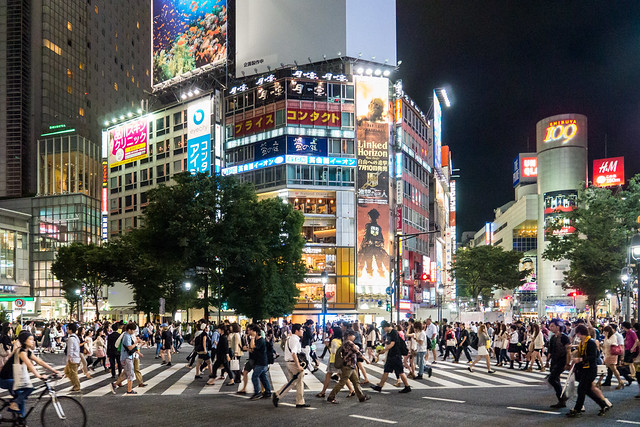
Kabukicho and Ginza:
At dusk and night because of the emblematic vertical neon lights. This is Kabukicho:
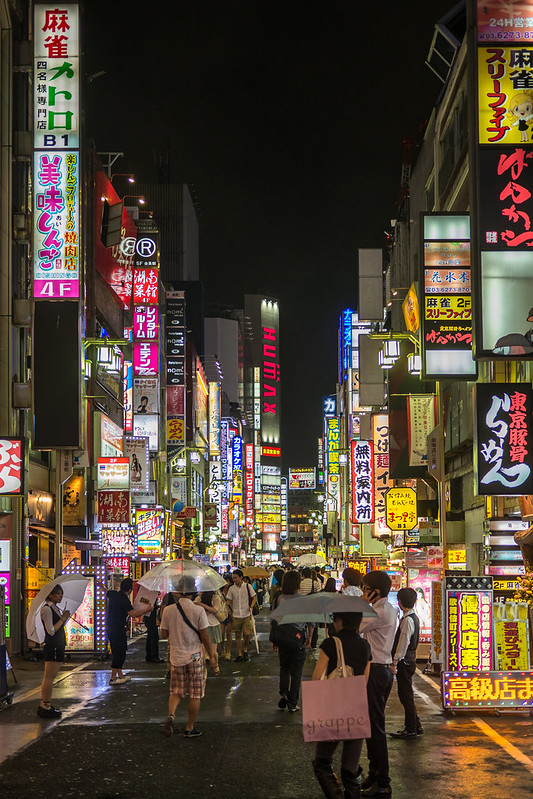
Shinjuku:
If you can afford such a hotel (we found good deals, twice, using booking.com), I highly recommend a short stay (or long, if you have the budget, you’ll want to stay there forever) at the Park Hyatt.
It spans the top of three towers with the eye of Sauron:

You could see this view:

Akihabara:
The district to go to, of course, to fulfill your cravings of hi-tech gadget purchases.
Odaiba island:
Take the Yurikamome monorail from Shimbashi (find a spot near the front of the train, never mind if you have to stand, the journey is worth it. You’ll travel trough sky scrapers, next to a three-mast ship, you’ll loop in the Rainbow Bridge after seeing it coming close, you’ll see the big ferris wheel of Odaiba).
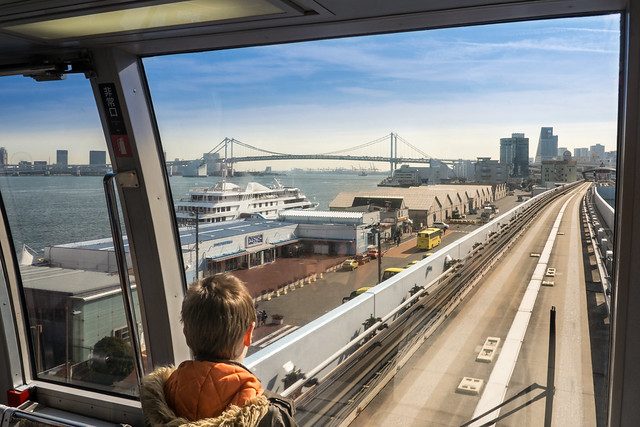

There’s a giant Gundam statue near the second Odaiba train stop; it’s quite a landmark (a 18-meter tall robot) with its big feet squarely planted in the ground.

Another landmark is the Statue of Liberty. It’s pretty anytime but perhaps it’s prettier at dusk, or at night, because it’s lit in colours of gold, or greenish, against the Tokyo skyline beyond a water expense. The Rainbow Bridge is lit as well and adds some beauty in the background of the statue.
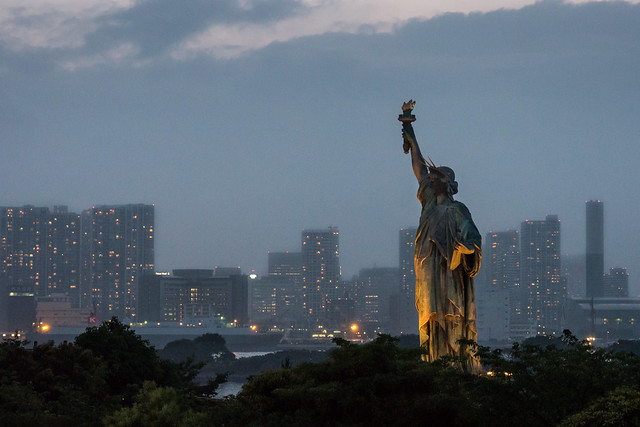
Another highlight from the Odaiba area is the Miraikan museum of emerging science and innovation. Admission fee of JPY 620 If you do three things while there, let it be contemplating the Tsunagari project (LED-equipped gigantic globe dangling from the ceiling), the Asimo exhibit/demo (a Honda 10 to 15 year-old robot that walks, runs, dances and sings) and the Androids.

Tsukiji Market:
Vlad said they plan to move the gigantic fish market somewhere else –it’s currently near-ish Ginza and they made space farther away for it, I don’t know when the move occurs.

Tsukiji Market is quite something! The most hard-core will show up at 4am and hope to be added to the list of the lucky few that can accompany the workers during the tuna auction. Otherwise, until 2pm you’ll see the exterior market areas teeming with humans; most selling fish and fish-stuff, others buying it, and yet others transporting Styrofoam crates on mopeds and other vehicles.

The noise, the smell, the cramped space all make for a memorable experience. No smoking, no luggage, no hindering allowed. You will probably be shoved and pushed, but it’s part of the experience.
For a break, you can try to get a seat at Yonemoto Coffee. A very small and very authentic coffee shop that serves excellent coffee and plays old jazz music. It looks like it is preserved in an era in the past. Even the owner looks like time has passed and not taken him in its journey forward.
Roppongi hills:
Maybe, to get a sense of the skyscrapers and where the white-collar workers go. There’s a giant spider, Maman by Louise Bourgeois, at the foot of the Mori Tower. It’s one of the five or so permanent locations for the impressive and creepy sculpture:
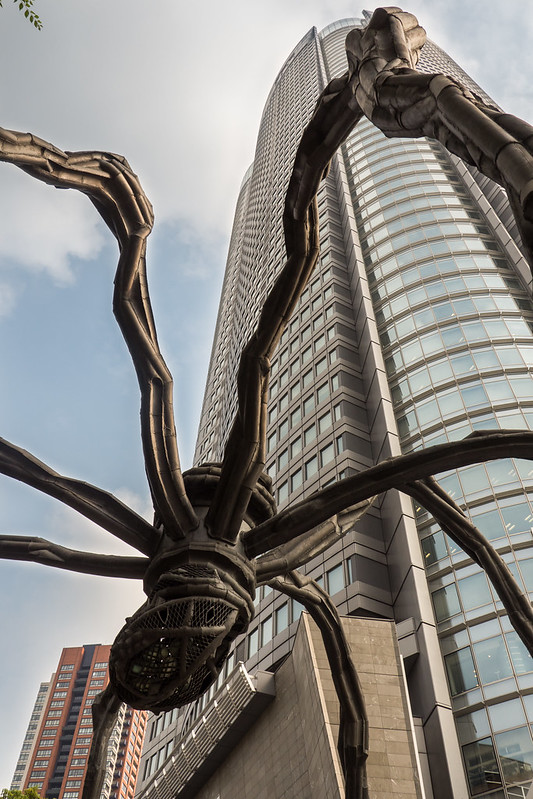
Tokyo observatory decks:
Here are some of the buildings on top of which you can see Tokyo and the Tokyo cityspace crawling as far as the eye can see:
45th floor of The Tokyo Metropolitan Government Building:
It’s free. You can look down on the Shinjuku Park Hyatt (the top of the three “eye of Sauron” joint-buildings is occupied by the hotel where Bill Murray and Scarlett Johansson filmed “Lost in Translation”):

Bunkyo Civic Center:
There’s a free observation deck on the 25th floor open 9am-8:30pm daily. We spotted Mount Fuji as the sun was sinking, a reminder that however big Tokyo is, there is this mountain looming, yet dwarfed at the left of the Shinjuku area Tokyo Metropolitan Government Building (twin towers that are fairly recognisable).

Mori Tower:
Miku Café, 52nd floor. Free admission. You’ll get such views as:

Tokyo Tower:
9am-10pm. There’s an admission fee. You can purchase a ticket (JPY 900) to reach the main observatory (150 m) or walk the stairs (we didn’t, they advertised it was a 13-minute climb and we weren’t up to it), and then purchase another ticket (JPY 700) to reach the Special Observatory (250 m). We didn’t spot Mount Fuji this time, as it remained enshrouded in clouds from the late afternoon till dark, but it’s visible if you’re lucky.
What to do and see in Tokyo [continued]
Yoyogi Park, pond, Meiji Shrine:
Meiji Shrine is where the souls of the Meiji Emperor and Empress are enshrined. It is also where they celebrate traditional weddings which processions you can witness. The Jingu Naien Iris Garden (there is a small admission fee, I forgot how much) might be worth of visit if the flowers are in bloom.


Harajuku, and Takeshita street:
These are natural next steps after Yoyogi Park. At the Harajuku exit of Yoyogi park, there’s an emblematic bridge where teens dressing according to Harajuku fashion (rock, punk, gothic, lolita) gather and hang out on Sundays.
Takeshita Dori is a small cramped street full to the brim with fashion shops and crepes take-away outlets.

Tokyo Imperial Palace Park:

What to see and do near-ish Tokyo
Enoshima:
45 minutes away from Tokyo center by train. It’s an island near Tsujido and Kamakura. It was described to me as the Mont Saint-Michel of Japan. It’s beautiful. If you’re lucky with the weather you can see Mount Fuji bigger and more impressive than anything you’re prepared for.

Kamakura:
If you’re at Enoshima, go next to Kamakura. There’s a giant Buddha that everybody goes to see. I went to Kamakura last month at last (5th time in Japan), but we didn’t go see the Buddha. We went to a sanctuary instead, specialised in money laundering. Well, sort of.
What to see and do outside of Tokyo
Kyoto:
We stayed there several days in June 2013 and loved it. We found that many people wore the traditional outfit. Far more than in Tokyo, I mean.


Gion:
Go to Gion, in the city center. You’ll see geikos and maikos.
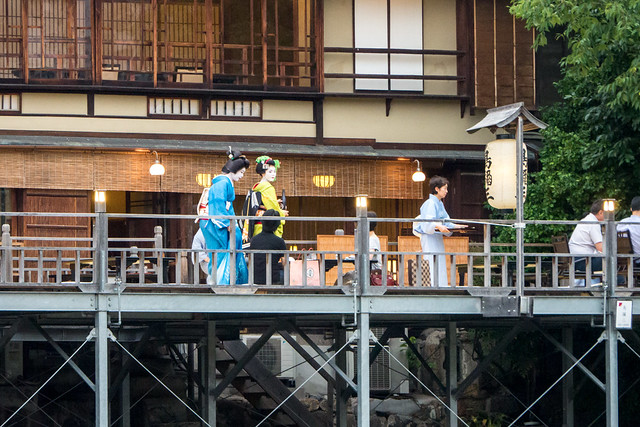
Yasaka shrine and pagoda:
Go to Yasaka shrine not far from Gion, it is astounding. There is a pavilion decorated with hundreds of paper lanterns. It’s a wonder at night.
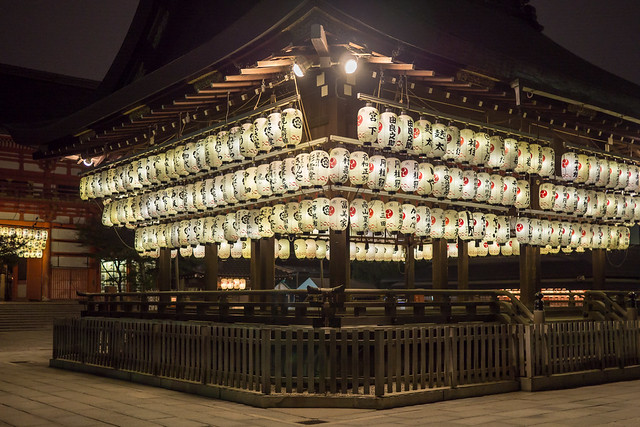
Nishiki Market:
Visit the Nishiki (covered) market not far from the city center.

Then, further away from Kyoto city center:
Inari Fushimi Taisha:
You need to walk some amount of time through the path of the thousands torii at Inari Fushimi Taisha. The path goes up the mountain for a long while (spans 4 kilometers and takes approximately 2 hours to walk up, dixit wikipedia). We were there under pouring rain and stayed as long as we had the heart for.
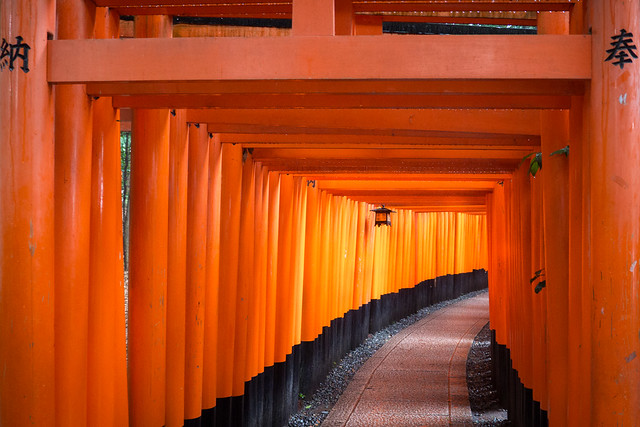
Kinkaku-ji, the Golden Pavilion:
You also need to see Kinkaku-ji, the Golden Pavilion.

Other Kyoto highlights include:
- The Nanzen-ji and the Philosopher’s path, as well as the nearby Ginkaku-ji (the Silver Pavilion).
- Arashiyama in the western suburbs of Kyoto (you need to take a train) for its bamboo grove, and famous bridge.
The Kyoto tower, close to the train station, wasn’t particularly exciting. Done with Kyoto!
Miyajima for Itsukushima island:
Situated not far from Hiroshima, the island of Miyajima is famous for the beautiful landmark of a floating torii.

There’s a ropeway to reach Mount Misen and if you’re lucky with the weather it’s breath-taking (we had rain, thick fog and heavy clouds, sadly, but it wasn’t a surprise as we visited in February).
We had not idea, but the island is full of deer! We later went to Nara, with a goal to see the deer (which we did, of course), but we had had a preview of the white-tailed deer already.

We stayed at Kurayada Hiroha, the most enchanting ryokan, but quite pricey (check the rate via booking.com). My favourite hotel of our February trip! Rooftop hot tub (one for men, one for women, separated by a fence) next to indoor hot tubs (same, separated ones for men and women) were excellent.
Kobe:
Kobe appears to be a narrow flat expanse of city bound by the sea on one side, and a steep mountain on the other. We had such bad weather, and stayed just one night and one morning, that we only got a sense of the mountain side of things by seeing advertisements in the subway. They advertised a ropeway from which it looked like the view on the city was lovely. I don’t know if you’ve been to Hong Kong, but the view reminded me a little of what you see from Victoria Peek.
What we went to Kobe for was two-fold: eating some of the world-renowned Kobe beef (it was delicious. I had no idea beef could melt on the tongue), and a few illuminated landmarks at the harbour (port tower, a ferris wheel, the oriental hotel shaped like a cruiser ship, the roof of the Kobe Maritime Museum shaped like a meshed sailing ship) which were beautiful at night. I’d say that it’s a photographer’s type of visit; beyond the photographs to be gotten, the area was deserted in the evening and it was quite a walk to reach it, and not so much an interesting one.

There is a Chinatown in Kobe, which looks pretty but little, and the district of Sannomiya appeared to us to be the heart of the town. You need to take the subway from the Kobe traing station to Sannomiya anyway. The night life in Sannomiya was lively. Loads of restaurants.
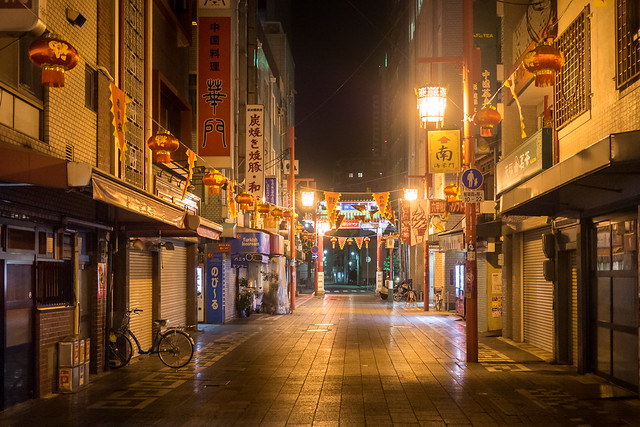
I read that there is an onsen resort nearby Kobe, but we had no idea, so I’ll leave it to you to investigate. Onsen is the term for hot springs as well as hot tubs. They can be indoors, or outdoors (roten-buro). Some allow mixed bathing, but from my experience, it isn’t common. And still, from experience, it appears that none allow tattoos to be visible.
Shiga Kogen ski resort / Jigokudani Monkey Park:
Speaking of onsen, one of the highlights of our February stay, because of the winter/snow, was seeing the snow monkeys of Jigokudani Monkey Park, bathing in a roten-buro:
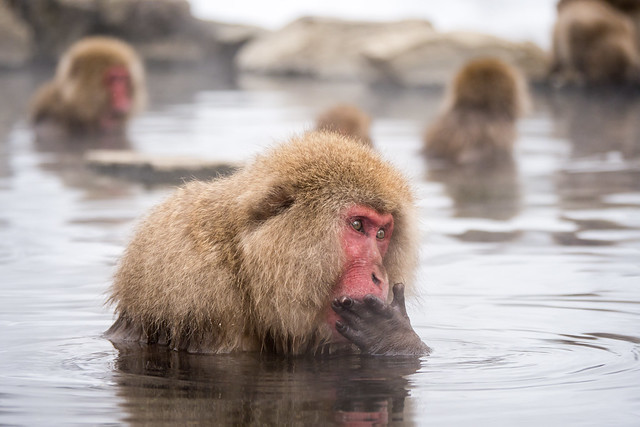
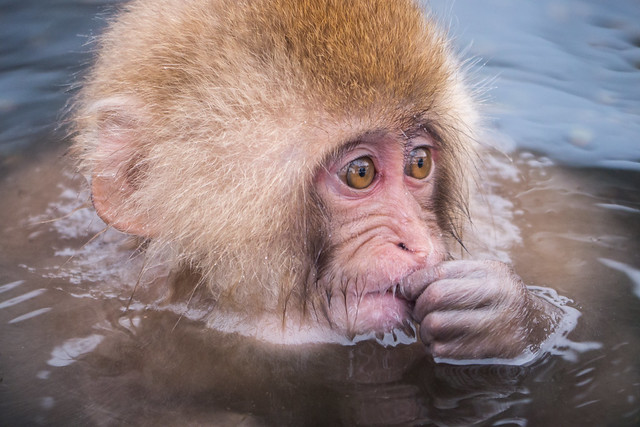
We took the train to Nagano and from there took another that got us close to the Shiga Kogen skiing domain. A combination of taxi and walking got us to that monkey park (small admission fee). I’m not sure how it looks in May and if it’s worth the hassle of transportation. It takes about 1.5 hours between Tokyo and Nagano and then another hour or so to reach Yudanaka.
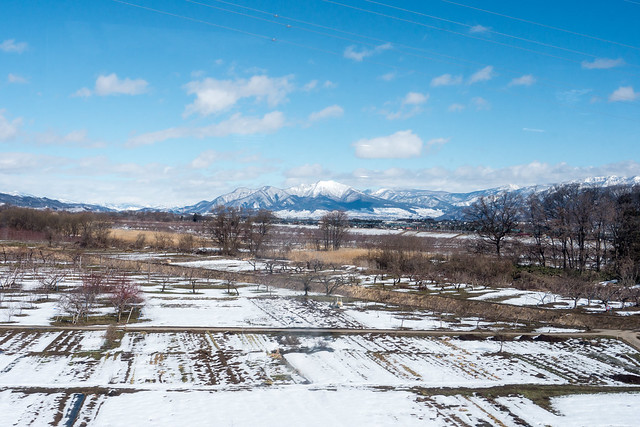
We went to other places in February –Hiroshima, Nara, Himeji– and although each place was fine, they didn’t make it to my highlight list.





